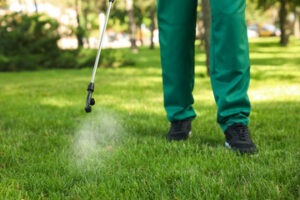Concrete Contractor Columbus is responsible for the construction and repair of crucial parts of homes and businesses. From patios to sidewalks, driveways and garages, quality workmanship from these professionals is essential for both beauty and functionality.

Ask potential contractors for references from past clients. Talk to them about timelines, costs and warranties to ensure your project is on track.
Concrete contractors are essential in shaping both the infrastructure and aesthetic appeal of residential and commercial spaces. Their job involves far more than just pouring and setting concrete—it’s a highly specialized and detailed profession that requires extensive knowledge of a wide range of materials, tools, and installation processes.
As such, concrete contractors are often passionate about their work and take great pride in creating something both tangible and long-lasting. Their dedication to the craft is what makes them an invaluable part of any construction project.
Professional concrete contractors have years of industry experience under their belts, allowing them to bring valuable insight and expertise to any project they take on. They can help you plan your concrete project from start to finish, helping you select the right materials and ensure that your finished product meets or exceeds your expectations.
In addition, they have the practical time management skills to keep projects running on schedule and avoid costly delays or do-overs. This is a critical trait that not only saves you money but also ensures that your finished product is top-notch.
A concrete contractor’s willingness to constantly improve their skill set is another crucial trait that enables them to remain at the forefront of their field. After all, the world of concrete construction is always changing, with new techniques and materials becoming available all the time. A willingness to learn is what separates the truly exceptional from those who are simply good at their jobs.
Exceptional Craftsmanship
A quality concrete contractor will take pride in their work and have a portfolio that showcases the scope of their expertise. Look for projects that are similar to your project requirements and ask if you can visit some of these sites in person to observe the craftsmanship. A reliable contractor will also be happy to provide references from past clients that you can contact to learn more about their experience working with the contractor. Ask about the contractor’s communication style and how they handled unexpected challenges during construction.
A good concrete contractor will be certified by a recognized industry organization, such as the National Ready Mixed Concrete Association (NRMCA). They’ll also keep up with the latest advancements and techniques in concrete construction, including decorative concrete finishes, so you can be sure they are using the best materials and methods to get the job done right.
When choosing a concrete contractor, be sure to check out their website and read public reviews on Google, Yelp, Facebook, and Angi. This will give you a good idea of the contractor’s reputation and customer service quality, as well as their ability to meet deadlines and budget expectations. A reputable contractor will also have a comprehensive warranty that details the duration of their guarantee and how they handle issues that arise after the completion of a project.
In addition, be sure to discuss the contracting process with any potential contractor and make sure they clearly outline the scope of work in a written agreement. This will protect your interests and ensure that all parties understand their responsibilities throughout the project, so there are no misunderstandings down the road. Also, insist on a clear contract that clearly outlines project timelines, costs, warranties, and other essential information.
Exceptional Attention to Detail
The quality of the final result depends on the contractor’s ability to precisely execute the design and construction plans. A trustworthy concrete contractor prioritizes accurate workmanship by adhering to established building codes and ensuring that every step of the process is executed properly. This level of dedication translates into superior results that stand the test of time.
When evaluating potential contractors, pay attention to their responsiveness, clarity, and consistency in their communication. Look for a contractor who is willing to answer your questions and provide detailed explanations of technical issues. Also, consider how often they provide project updates and ask for feedback throughout the construction process.
Whether you need stamped concrete for your decorative patio, exposed aggregate for your modern driveway, or a decorative overlay for your commercial floor, choosing the right contractor can make all the difference in the outcome. Select a contractor who has demonstrated experience in your specific type of concrete work. Specialized knowledge and expertise ensure that your vision is fully realized with precision and finesse.
A reputable concrete contractor will demonstrate their professionalism and reliability by providing references from past clients and providing proof of their credentials and insurance coverage. Additionally, they will offer a comprehensive quote for their services, including a breakdown of costs and any additional fees. This will help you compare prices and choose the best option for your budget. It is also important to request a contract agreement that clearly outlines project details, timelines, payment terms, and warranty information. A contract protects both parties and prevents misunderstandings throughout the duration of the project. This is especially critical if you are planning a large-scale construction project that will require significant coordination between various subcontractors.
Top-Notch Construction Quality
The construction quality provided by your concrete contractor is a major factor that determines how long your project will last. A reputable and reliable company should be able to provide you with a wide variety of projects that demonstrate their ability to perform high-quality work. Look for testimonials online or ask friends and family for recommendations. You can also contact past clients directly to find out about their experience working with the contractor.
You can also inquire about the type of materials and techniques they use to ensure top-notch results. A reputable concrete contractor should be knowledgeable about the different concrete mixes that can be used for various applications and should have up-to-date knowledge of the latest innovations in concrete technology. This is an important way to ensure your concrete project will meet or exceed your expectations for durability and aesthetics.
It’s also a good idea to find out how they plan to handle any legal issues that may arise during the project. A reputable concrete contractor should be able to work with you to resolve any issues in a professional and responsible manner.
You should also inquire about their pricing structure. A transparent pricing structure can help avoid misunderstandings and unexpected costs later on in the process. You can also ask about their payment schedule and whether they offer any financing options. Finally, you can ask how they typically keep their clients informed about the progress of the project and their policy for addressing client feedback. This will help you find out if they prioritize open communication with their clients. If they do, you can be confident that you’ll have a smooth construction process from start to finish.
Exceptional Customer Service
A quality concrete contractor will have a commitment to outstanding customer service. This quality is evidenced by transparent communication, prompt responses to emails and phone calls, and clear explanations of project scope and price. In addition, the contractor should be able to adjust project timelines as needed and accommodate changes in the project plan.
Another sign of a quality contractor is an emphasis on safety protocols. The contractor should follow all local and state regulations for safe work practices. A reputable contractor will also adhere to industry standards for materials and workmanship.
Before selecting a contractor, get multiple quotes and compare prices. Examine the contractor’s portfolio and request references. This will help you select the right contractor for your concrete repair or installation project. Ensure that you choose a contractor who has experience working on projects that are similar to yours. This way, they will better understand the techniques involved in your specific project and can make accurate estimates.
Check the contractor’s insurance and licensing. This is a necessity for any home improvement or construction project. Licensing is typically required for a construction job, especially one involving heavy machinery and potential hazards.

